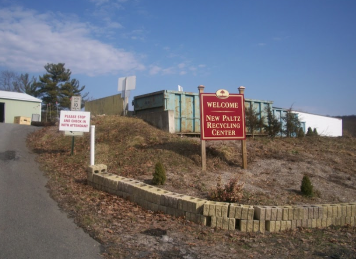
As of March 22, the Town of New Paltz has committed to the Hudson Valley Regional Council (HVRC)’s Landfill Project Application. This application will be submitted to the Environmental Protection Agency (EPA)’s Climate Pollution Reduction Grant Program to fund municipal landfill emissions mitigation in the Mid-Hudson Region.
As an organization, HVRC provides technical support across the seven-county Mid-Hudson Region and assists participating municipalities in government operations like greenhouse gas (GHG) inventories. Through these functions, the council has observed that closed landfills are often the largest source of emissions. “The idea for this project came from one community that did a GHG inventory and found that its closed landfill made up 90% of the government’s GHG emissions,” said HVRC Climate Smart Communities Coordinator, Melanie Patapis.
The Town of New Paltz, like the surrounding municipalities, has completed GHG inventories and climate action plans. “We understand the sources of emissions in our community and know that our closed landfill methane emissions are insidious drivers of emissions,” said former Town Supervisor Neil Bettez.
The proposed project aims to reduce fugitive methane emissions from closed landfills in the region through the installation of biofilters, which will be built at the gas vents on the participating landfills. A biofilter consists of organic material, often compost and wood chips or mulch, and methanotrophs – a methane eating microbe that naturally occurs in methane influenced environments. The filters will be hooked up to landfill gas vents to filter the gas before it enters the atmosphere. They are a low-cost measure shown to remove methane from landfill gasses at a 90% efficiency rate.
“This is exciting because it will be a pioneering effort, since biofilters have not yet been implemented in New York, that I am aware of,” Patapis said. “It will also establish best practices for design, implementation and monitoring to make this project replicable at other municipality-owned closed landfills across the region and state. The impact of greenhouse gas reductions for low cost is significant, given that emissions from closed landfills are often overlooked.”
“As a New York State Climate Smart Bronze Certified Community and New York State Energy Research and Development Authority (NYSERDA) Designated Clean Energy Community, the town of New Paltz understands the importance of reducing our community’s greenhouse gas emissions,” Bettez wrote in his letter of commitment to HVRC’s application. “We are eager to be part of a group of Mid-Hudson municipalities working to significantly reduce emissions from our closed landfill.”
New Paltz is one of 14 municipalities with municipal-owned, closed landfills that have signed letters of commitment to be included in the council’s grant application. Others include the towns of Amenia, Bethel, Gardiner, Hurley, North East, Philipstown, Rhinebeck, Wallkill and Woodstock, the Village of Mamaroneck and the City of Beacon.
The project would also involve several organizations, which have recently been contacted by the council for consultation. These include the Department of Environmental Conservation (DEC)’s Division of Materials Management to understand compliance requirements for town landfills, the New York State Climate Pollution Reduction Grants (CPRG) program, the New Jersey Institute of Technology Technical Assistance for Brownfields Program (NJIT TAB) for support with community engagement requirements and Aspect Consulting for expertise on biofilter design and implementation.
A rough draft of the proposed work plan for the project, to be done primarily by HVRC, NJIT TAB and consulting engineering firms, has been sent inside the EPA grant application, as well as to town officials. The proposed functions of the project are as follows: To monitor methane emissions from each landfill, by taking inventory and identifying the vents producing the most methane and monitoring them monthly. To install biofilters, working with the DEC to secure land-use change approvals, hiring engineering, construction and data emissions expert consultants and constructing and maintaining the biofilters. To evaluate the efficiency of emissions reduction and review data to ensure the biofilters are working correctly. To support biodiversity and climate resilience on landfills, especially focusing on increasing the populations of native plant species. To install solar and/or battery storage on the landfills, after determining the feasibility of solar power for landfills that do not yet have it but want it. And finally, to share knowledge about reducing emissions and the productive reuse of closed landfills, educating community members and helping to expand the use of biofilters, landfill solar and storage and native plantings in the region and state.
“The Town of New Paltz looks forward to having a solar feasibility study completed for our landfill,” Bettez said. “We hope the study will reveal that the benefits of solar energy can be brought to our closed landfill.”
This multi-municipal effort will help New York State meet the goals of the Climate Leadership and Community Protection Act – to eliminate 100% of climate pollution caused by humans, calling for an 85% reduction in GHG emissions by 2050, with an interim target of 40% by 2030 – as well as the United States’ goal to reduce greenhouse gas emissions by 50% by 2030.
“This project will bring more awareness to the issue and mitigate emissions from our communities, helping us to do our part to stop climate change,” Bettez said.
This initiative is particularly time-sensitive, because “landfills can emit toxic gases and other air pollutants into the air, even after they are closed, which can be hazardous to human health,” Patapis said. “This project would result in improved air quality around the landfills and may also improve the air quality of surrounding communities.”
However, grant allocations are not anticipated to be announced until this summer, so HVRC and the Town of New Paltz are eagerly awaiting the results. If the funds are awarded, the landfill emissions mitigation project would be expected to commence operations in early 2025.
